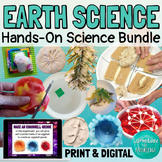Modeling the Rock Cycle with Starburst Science Lab Experiment PRINT and DIGITAL
- PDF
What educators are saying
Also included in
- This rock cycle unit bundle includes 9 one hour geology lesson plans with all of the resources needed to implement them in your science classroom. The unit explains how rocks change between 3 types of rocks: sedimentary (weathering, erosion, compaction, and cementation), igneous (melting and coolingPrice $22.40Original Price $32.00Save $9.60
- This bundle includes 10 hands-on science labs and activities all related to the Earth: rocks, fossils, minerals, crystals, tectonic plates, earthquakes, volcanoes, paleontology, etc. This bundle includes: Experiment: Modeling the Rock Cycle with StarburstExperiment: Modeling Tectonic Plates with GraPrice $22.20Original Price $37.00Save $14.80
Description
In this hands-on science lab experiment, students use Starburst candies to model how rocks can change between sedimentary, igneous, and metamorphic rocks in the rock cycle. Students will use scissors, hot water, and an iron to simulate weathering and erosion into sediment, melting and cooling, heat and pressure.
This resource includes:
- Teacher directions, discussion questions, and extension activities
- 5 pages of background information about the rock cycle
- 11 pages of directions that walk students through the activity step by step with photos of each step.
- A student record sheet
- Student response questions
- A scoring rubric
- A force copy link to a Google Slides digital version (including a digital, drag and drop version of the response page and response questions)
Please follow my store here for more great resources!
You can also find me on Facebook, Instagram, and lafountaineofknowledge.com where you'll discover ideas, inspiration, and plenty of freebies! Or join my email list to get a monthly newsletter with exclusive FREE resources you can't get anywhere else!
Want free money to spend on Teachers Pay Teachers? Rate this product to earn some TpT credit! Leaving feedback helps us both out and takes less than a minute! Your support makes it possible for me to continue making and sharing great resources! Thank you!







